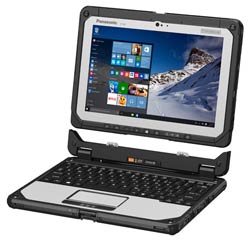Around 15 years ago, Microsoft announced the Windows Tablet, and a lot of us forecast that this represented the end of notebook computers and that we’d all move to this new form factor. This forecast was only amazing in that it was totally wrong. It wasn’t that the idea wasn’t good. The idea of a laptop that could be carried like a tablet was a good one, but there were a few significant problems. The Windows Tablet was big, heavy, had horrible battery life, and was really expensive when compared to the laptops of the time. In short, the implementation was horrid. But here it is around 15 years later and we like tablets. Products like the new Surface Pro are both attractive and competitively priced and they have battery life and weight more in line with tablets than what we are used to in laptops.
The Panasonic Toughbook 20 is simply the latest iteration in what is a sea change in terms of laptop/tablet design, and since it sells to government and military, this move into the hybrid 2-in-1 space indicates that we are well along the way to eliminating traditional laptops and replacing them with this form factor.
Panasonic Toughbook 20
Panasonic is to Apple what General Dynamics is to Tesla. In the PC space, it builds laptops that are designed to work on the battlefield. It didn’t lead on design revolutions; it lags because it is more about stability, reliability and survivability than sexy designs and low prices. Or, put differently, if your life depended on your PC, you’d likely buy a Panasonic.

Since this is a removable screen laptop, it has six potential configurations. These include laptop and traditional tablet. In laptop mode, the screen can be reversed for presentations. With the built-in handle, the device can be hung on the wall for presentations, carried, or vehicle mounted.
It is designed to work with a variety of accessories, including vehicle docks (military, law enforcement, delivery), smart card readers (hospitality, health care), desktop docks (business, government), and pens (forms). Security solutions range from smartcard readers to biometrics, and there are Kensington lock ports for both the tablet and keyboard to prevent against sticky fingers.
This uses Intel’s new Skylake processor with the requisite improvements in battery life and performance.
As with other hybrids, price is comparable to a similar notebook form factor product which, in the military spec space, is around $3K.
Wrapping Up: Customer Driven Form Factor
While the typical OEM will build against the promise of a market that either Intel or Microsoft has showcased in a new design and thus lead the market, vendors like Panasonic tend to be customer driven and lag the market. When it moves to a new design, it is only as a result of customers who actually have a need for the new form factor. The move to a hybrid design with a removable tablet component showcases that even lagging segments of the market (military, law enforcement) are seeing the need for this new form factor, suggesting that we are well into a transition away from traditional laptops to 2-in-1 laptop/tablet hybrids.
So, this time, it does look like the traditional laptop is giving way to the 2-in1 for a lot of us. What strikes me about the Panasonic is that the concept of a high-nit screen that is outdoor viewable (doesn’t wash out) should be on more products in this class, not just those that are targeted at the military. We’ll see if more mainstream products pick it up.
Until then, the Toughbook 20 kind of stands alone in this space and goes a long way to validating the removable tablet 2-in-1 form factor.
Rob Enderle is President and Principal Analyst of the Enderle Group, a forward-looking emerging technology advisory firm. With over 30 years’ experience in emerging technologies, he has provided regional and global companies with guidance in how to better target customer needs; create new business opportunities; anticipate technology changes; select vendors and products; and present their products in the best possible light. Rob covers the technology industry broadly. Before founding the Enderle Group, Rob was the Senior Research Fellow for Forrester Research and the Giga Information Group, and held senior positions at IBM and ROLM. Follow Rob on Twitter @enderle, on Facebook and on Google+



